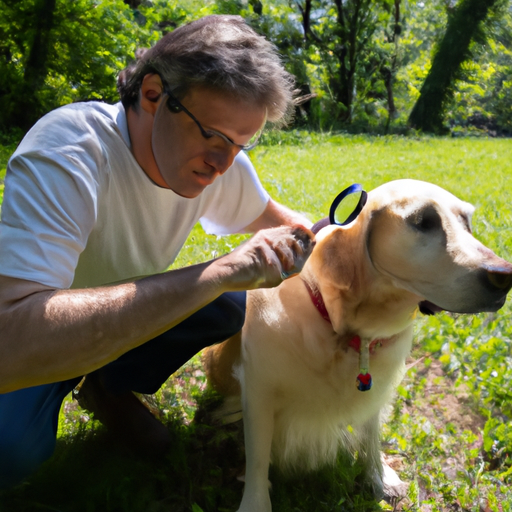Understanding the Danger of Ticks
Ticks are more than just a nuisance, they pose a real health threat to your four-legged friends. They are carriers of various diseases, including Lyme disease, Anaplasmosis, and Ehrlichiosis, which can be fatal if left untreated. As a caregiver, you should be extra vigilant in protecting your pet from these tiny parasites.
To give you an idea, below is a table showing some common diseases transmitted by ticks and their symptoms:
| Disease | Symptoms in Dogs |
|---|---|
| Lyme disease | Fever, loss of appetite, reduced energy, lameness |
| Anaplasmosis | Joint pain, fever, lethargy, loss of appetite |
| Ehrlichiosis | Depression, weight loss, fever, bleeding disorders |
Regular Tick Checks
Regular tick checks are the first line of defense in tick prevention. A thorough examination of your pet’s body can save them from potential health risks. Best practice is to check your dog every time they’ve been outside, particularly in wooded or grassy areas.
Here’s a simple step-by-step guide:
- Start at the head and work your way down to the tail.
- Run your fingers through the fur, feeling for small bumps (ticks can be as small as a pinhead).
- Pay special attention to areas where ticks tend to hide: under the collar, ears, armpits, groin, and between toes.
Tick Removal Techniques
If you find a tick on your dog, don’t panic! Here’s what you need to do:
- Get a pair of fine-tipped tweezers: Regular tweezers may not remove the tick completely, leaving parts embedded in the skin.
- Grasp the tick as close to the skin as possible: Be careful not to squeeze the body of the tick as it may release bacteria into your dog’s bloodstream.
- Pull upward with steady pressure: Avoid twisting or jerking as it may cause the tick’s mouth-parts to break off and remain in the skin.
Preventive Measures
Prevention is always better than cure. Here are some tips to keep your pet tick-free:
- Use tick preventive products: There are various products available, such as spot-on treatments, oral medications, tick collars, and sprays.
- Maintain your yard: Keep grass mowed and bushes trimmed. Remove leaf litter and clear tall grasses to reduce tick habitats.
- Avoid tick-infested areas: If possible, avoid walking your dog in wooded and grassy areas especially during tick season.
FAQ
Q: How quickly can ticks infest a dog?
A: Ticks can latch on to your dog as quickly as they brush past a grass blade or leaf. Therefore, it’s important to check your dog for ticks regularly.
Q: Can ticks spread from dogs to humans?
A: Yes, ticks can spread from dogs to humans. If you find a tick on your dog, it’s a good idea to check yourself as well.
Q: What should I do if a tick’s head is left in the dog’s skin after removal?
A: If a tick’s head is left in the skin after removal, consult a vet immediately to avoid infection.
Q: How can I prevent my dog from getting ticks?
A: Using tick preventive products, maintaining your yard, and avoiding tick-infested areas can help keep your dog tick-free.
Remember, your dog relies on you for their health and happiness. Stay alert, informed, and proactive in protecting them from ticks and other parasites.



